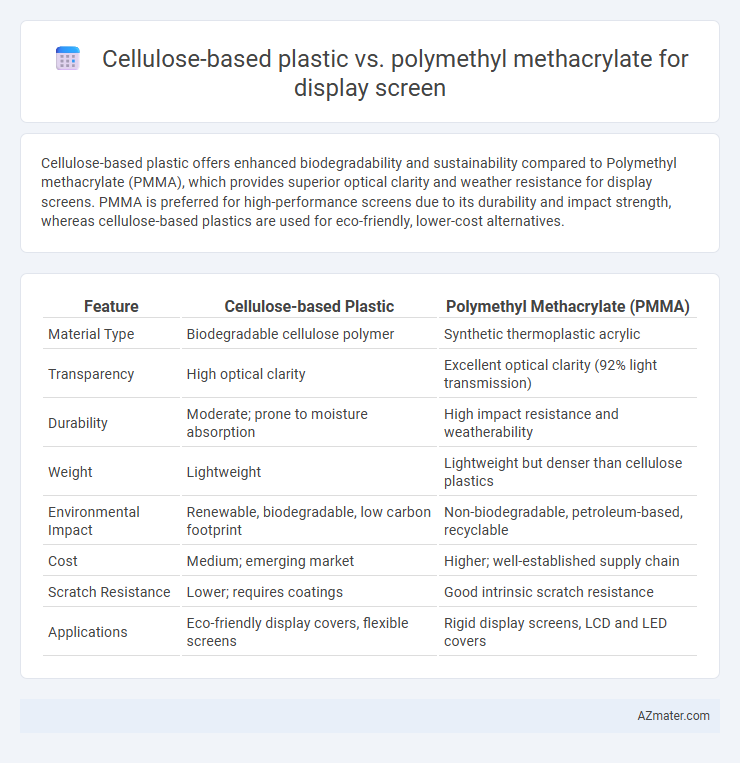Cellulose-based plastic offers enhanced biodegradability and sustainability compared to Polymethyl methacrylate (PMMA), which provides superior optical clarity and weather resistance for display screens. PMMA is preferred for high-performance screens due to its durability and impact strength, whereas cellulose-based plastics are used for eco-friendly, lower-cost alternatives.
Table of Comparison
| Feature | Cellulose-based Plastic | Polymethyl Methacrylate (PMMA) |
|---|---|---|
| Material Type | Biodegradable cellulose polymer | Synthetic thermoplastic acrylic |
| Transparency | High optical clarity | Excellent optical clarity (92% light transmission) |
| Durability | Moderate; prone to moisture absorption | High impact resistance and weatherability |
| Weight | Lightweight | Lightweight but denser than cellulose plastics |
| Environmental Impact | Renewable, biodegradable, low carbon footprint | Non-biodegradable, petroleum-based, recyclable |
| Cost | Medium; emerging market | Higher; well-established supply chain |
| Scratch Resistance | Lower; requires coatings | Good intrinsic scratch resistance |
| Applications | Eco-friendly display covers, flexible screens | Rigid display screens, LCD and LED covers |
Introduction to Display Screen Materials
Cellulose-based plastics offer renewable, biodegradable alternatives for display screen materials, characterized by their lightweight nature and flexibility. Polymethyl methacrylate (PMMA) provides superior optical clarity, scratch resistance, and weatherability, widely used in high-performance screens and protective covers. Comparing cellulose-based plastics with PMMA reveals trade-offs between environmental impact, mechanical properties, and optical performance in display technology applications.
Overview of Cellulose-Based Plastics
Cellulose-based plastics, derived from natural cellulose fibers, offer sustainable and biodegradable alternatives to traditional display screen materials like Polymethyl methacrylate (PMMA). These bio-based plastics exhibit good optical clarity, mechanical strength, and UV resistance, making them suitable for eco-friendly display applications. Unlike PMMA, cellulose-based plastics reduce reliance on fossil fuels and decrease environmental impact through enhanced recyclability and lower carbon footprint.
Key Characteristics of Polymethyl Methacrylate (PMMA)
Polymethyl methacrylate (PMMA) is a lightweight, transparent thermoplastic known for its exceptional optical clarity and UV resistance, making it ideal for display screens. Its high scratch resistance and weatherability outperform many cellulose-based plastics, providing durable protection while maintaining brightness and color fidelity. PMMA also offers excellent dimensional stability and ease of fabrication, ensuring precise and reliable screen applications.
Optical Clarity: Cellulose-Based Plastics vs PMMA
Cellulose-based plastics offer moderate optical clarity with light transmittance typically ranging from 85% to 90%, making them suitable for certain display screen applications requiring natural material alternatives. Polymethyl methacrylate (PMMA) provides superior optical clarity with light transmittance often exceeding 92%, delivering a brighter, clearer display image and higher scratch resistance. The higher refractive index and lower haze of PMMA contribute to better contrast and sharpness compared to cellulose-based plastics in display screen technologies.
Mechanical Strength and Durability Comparison
Cellulose-based plastics exhibit moderate mechanical strength and good impact resistance but generally lack the rigidity and scratch resistance of polymethyl methacrylate (PMMA), which offers superior hardness and durability ideal for display screens. PMMA provides excellent tensile strength and resistance to environmental factors such as UV radiation and moisture, enhancing its longevity compared to cellulose-based alternatives prone to degradation over time. The choice between these materials depends on balancing sustainable biodegradability of cellulose plastics against the high performance and durability requirements met by PMMA in display screen applications.
Environmental Impact and Sustainability
Cellulose-based plastics offer a significant environmental advantage over polymethyl methacrylate (PMMA) due to their biodegradability and renewability, as they are derived from natural cellulose fibers that decompose more readily in the environment. PMMA, a petroleum-based polymer, poses greater ecological concerns because it resists degradation and contributes to long-term plastic pollution, despite its durability and optical clarity. Choosing cellulose-based materials for display screens supports sustainability goals by reducing carbon footprint and reliance on fossil resources while enabling easier recycling and waste management.
Cost-Effectiveness and Market Availability
Cellulose-based plastics offer a sustainable alternative for display screens, providing cost-effectiveness through lower raw material expenses and biodegradability, though their performance may lag compared to Polymethyl methacrylate (PMMA). PMMA dominates the market with widespread availability, superior optical clarity, and durability, supporting higher-end display applications despite higher production costs. The choice between these materials hinges on budget constraints and environmental considerations, with cellulose-based plastics gaining traction in eco-conscious sectors while PMMA remains the industry standard for premium displays.
Processing and Fabrication Techniques
Cellulose-based plastics for display screens leverage biodegradable polymers processed through solvent casting and extrusion, offering eco-friendly fabrication with lower energy consumption. Polymethyl methacrylate (PMMA) employs techniques like injection molding and thermoforming, delivering high optical clarity and precise dimensional control essential for display applications. While cellulose-based materials require careful moisture control during fabrication, PMMA offers more established scalability for mass production in display manufacturing.
Real-World Applications in Display Technologies
Cellulose-based plastics offer superior biodegradability and reduced environmental impact compared to polymethyl methacrylate (PMMA), making them increasingly favored in sustainable display technologies. PMMA remains preferred for high-clarity, scratch-resistant display screens in smartphones, monitors, and televisions due to its excellent optical transparency and durability. Emerging applications integrate cellulose-based composites in flexible and curved displays, addressing environmental concerns while maintaining sufficient mechanical strength and optical performance.
Future Prospects and Innovations
Cellulose-based plastics offer promising sustainability advantages for display screens due to their biodegradability and renewable origin, aligning with growing environmental regulations and consumer demand for eco-friendly electronics. Polymethyl methacrylate (PMMA) remains favored for its superior optical clarity, durability, and ease of processing, but ongoing innovations aim to enhance its recyclability and reduce carbon footprint. Future developments in hybrid composites and nano-engineered cellulose derivatives could bridge performance gaps, enabling more sustainable yet high-performance display technologies.

Infographic: Cellulose-based plastic vs Polymethyl methacrylate for Display screen
 azmater.com
azmater.com